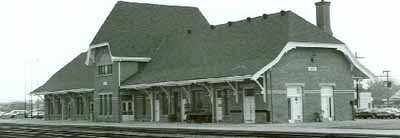VIA Rail Station
Heritage Railway Station of Canada
Sarnia, Ontario

General view
(© Heritage Research Associates Inc., M. Carter, 1994.)
Address :
125 Green Street, Sarnia, Ontario
Recognition Statute:
Heritage Railway Stations Protection Act (R.S.C., 1985, c. 52 (4th Supp.))
Designation Date:
1995-05-16
Dates:
-
1891 to 1891
(Construction)
Event, Person, Organization:
-
Grand Trunk Railway
(Organization)
-
Joseph Hobson
(Architect)
-
George H. Proctor
(Builder)
Other Name(s):
-
Grand Trunk Railway Station
(Other Name)
-
Sarnia Tunnel Station
(Other Name)
-
Canadian National Railways Station
(Other Name)
Research Report Number:
RS-241
Description of Historic Place
The VIA Rail Station at Sarnia is a two-storey, brick railway station, built in 1891. The formal recognition is confined to the railway station building.
Heritage Value
The VIA Rail Station at Sarnia has played a vital, ongoing role in international trade, transportation and immigration between Canada and the United States for over 100 years. Known as “Tunnel Station”, the Grand Trunk Railway (GTR) built it as the Canadian terminus and maintenance depot for the St. Clair Tunnel, the world’s first international underwater train tunnel. The station was a key immigration centre for western settlers travelling by train between Canada and the United States. It also served as a major international transfer point for cross-border trade.
The VIA Rail Station at Sarnia is an excellent example of the design work of GTR Chief Engineer Joseph Hobson, with its symmetrical proportions and emphasis on height rather than bulk. The station is also an example of the construction work of George H. Proctor, who provided the requisite late-19th-century detailing.
The VIA Rail Station at Sarnia is highly prized by the community. It maintains its symbolic connection with the St. Clair Tunnel.
Sources: Heritage Character Statement, VIA Rail Station, Sarnia, Ontario, March 1995; Heritage Research Associates Inc., Railway Station Report 241, VIA Rail Station, Sarnia, Ontario.
Character-Defining Elements
Character-defining elements of the VIA Rail Station at Sarnia include: its long, high and narrow massing, consisting of a narrow, projecting, two-storey, central block flanked by long, one-storey, side wings and capped by high, steeply pitched, hipped-gable roofs; its prominent roof line, consisting of an extremely high, hipped-gable roof with slightly bellcast side eaves over the two-storey block and intersected by long, hipped-gable roofs with broad, bellcast, overhanging eaves over the one-storey wings; its features typical of late-19th-century railway stations, including a rectangular plan, prominent roofs, wide, overhanging eaves, large wooden brackets and a projecting operator’s bay on track side; its fenestration, consisting of tall, narrow windows, in single, double or triple groupings and a quintupled arrangement of small windows on the second storey, topped by a large arched transom; its exterior masonry, including red brick laid in Flemish bond, a string course in a varied colour of brick, stone accents at lintels and sills and brick soldier courses and herringbone patterns forming arches around the grouped windows of the two-storey block; the surviving original exterior woodwork, including boarded soffits, decorative bargeboards and elaborate brackets under the eaves; the regular rhythm of openings, spaced between the eaves brackets; the detailing introduced by the builder, which enhances the design, including wooden brackets on the gables, a variegated brickwork band that sits high on the station body, stone window sills and window surrounds outlined in a varied colour of brick.